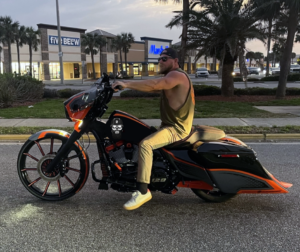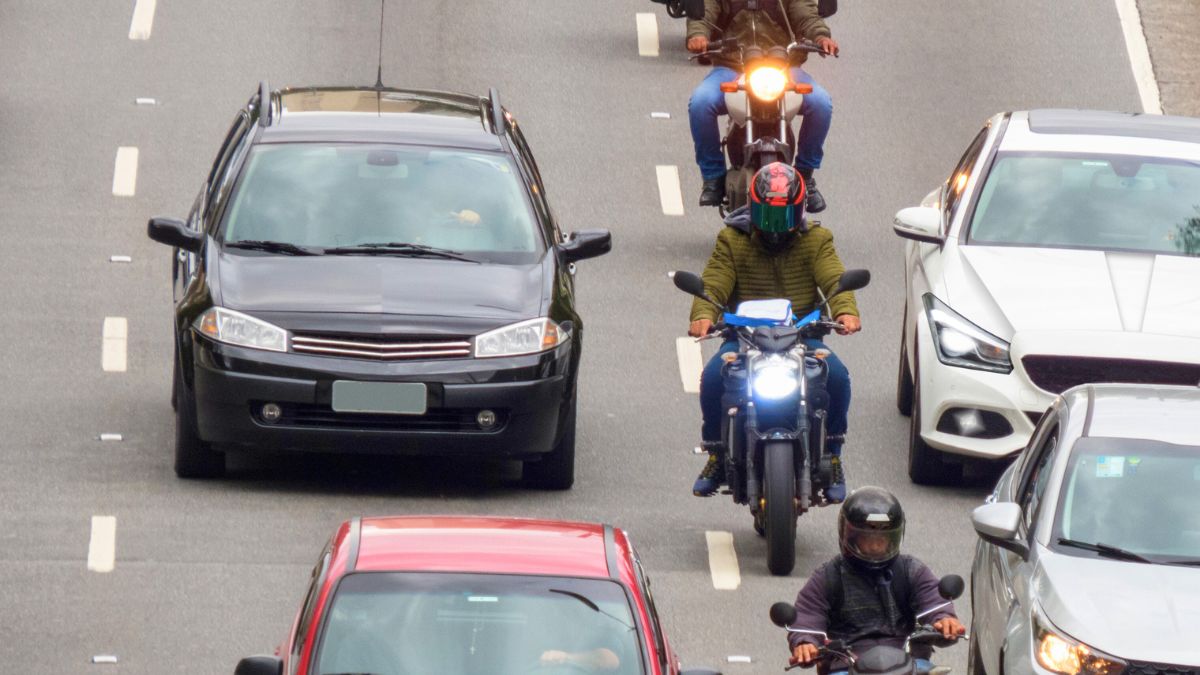
Lane-splitting, where a motorcyclist rides between lanes of slower or stopped vehicles, has long been a point of debate across the U.S. While common in a handful of states, the practice has faced limitations or outright bans in others. Minnesota recently joined the few states that allow lane splitting, which will go into effect July 1, 2025.
With Minnesota’s new lane-splitting laws for motorcycles, motorcyclists now face a fresh set of guidelines designed to enhance their commuting options while aiming to balance safety for all road users. Starting July 2025, motorcyclists will be allowed to split lanes in certain circumstances, and vehicle drivers can face penalties for trying to block or prevent a biker from splitting lanes.
These new regulations carry implications for both motorcyclists and other drivers in Minnesota. For motorcyclists injured in an accident caused by another driver, understanding these changes could be essential for protecting one’s right to fair compensation.
If you believe another driver’s actions played a part in a motorcycle crash that hurt you or a loved one, a motorcycle accident attorney can help you assess your case and guide you on potential next steps.
Injured in Minnesota? Get Nicolet.
What is Lane-Splitting?
Lane-splitting is when a motorcyclist rides between lanes of slow-moving or stopped vehicles to get through congested traffic. A similar concept is lane-filtering, where motorcyclists move to the front of a line of stopped cars, such as at a red light.
Lane-splitting is often praised for its potential to reduce rear-end collisions for motorcyclists caught in stop-and-go traffic. However, it’s also controversial due to the risks involved, particularly the danger of a collision when drivers switch lanes unexpectedly.
Minnesota’s Recent Changes to Lane-Splitting Laws
Before recent changes, Minnesota law prohibited lane-splitting altogether. This meant motorcyclists were expected to stay within a single lane, like other vehicles, rather than moving between them. Any attempt to ride between lanes could result in a traffic violation, and, in the event of a crash, lane-splitting would likely place some or all of the responsibility on the motorcyclist. This policy limited Minnesota riders’ options for navigating congested traffic, particularly on busy highways.
Summary of New Legislation
Minnesota’s new lane-splitting laws now allow certain circumstances where lane-splitting is permitted, but they include rules to regulate it. According to recent updates, motorcyclists are allowed to lane-split at low speeds when traffic is moving slowly. Bikers must stay under 25 miles per hour, and they cannot go more than 15 miles an hour faster than the car next to them.
The practice may be restricted to certain types of roadways, such as multi-lane highways, to avoid increased risk in urban settings where cars frequently change lanes. Lane-splitting may be limited during specific traffic conditions, and any riding that endangers pedestrians, cyclists, or other vehicles could still lead to fines. The law does not condone motorcyclists to engage in reckless behavior, such as speeding through stopped traffic, weaving through lanes, or racing through congested traffic. The law also does not require motorcyclists to split lanes, it only permits the practice.
Safety Considerations
The new law on lane-splitting could help motorcyclists avoid common accidents, like rear-end collisions in heavy traffic. However, lane-splitting also comes with risks, especially in Minnesota’s varied traffic conditions.
Some drivers may not expect motorcyclists to pass between lanes, and other drivers may purposely try to thwart a motorcyclist from lane splitting. Motorcyclists should remain vigilant about the position of other vehicles and avoid lane-splitting if traffic conditions make it unsafe.
Rights and Responsibilities
Minnesota’s new laws give motorcyclists additional rights, but also responsibilities. While lane-splitting can be convenient, motorcyclists need to be aware of their responsibilities under the law. This includes remaining within the allowable speed limits and avoiding sudden lane changes. By observing these guidelines, motorcyclists can reduce the chance of accidents and potential disputes over liability—they can also help ensure this safety measure remains in place.
Affect on Insurance and Liability
Minnesota’s new lane-splitting law could have significant effects on accident liability. If a motorcyclist is in an accident while legally lane-splitting, insurers and courts may no longer assume the motorcyclist is at fault. This shift could improve options for fair compensation, especially if another driver acted recklessly. But insurers may still try to assign partial responsibility to the motorcyclist, making legal guidance essential for any motorcyclist injured in such accidents.
What Other Drivers Need to Know About Lane-Splitting
Drivers should stay aware of motorcyclists who may be lane-splitting, especially in slow or stopped traffic. Minnesota’s new lane-splitting laws expect drivers to avoid sudden lane changes or actions that could endanger nearby motorcyclists. Watching mirrors and maintaining steady lane discipline allows motorcyclists to pass safely without unexpected obstacles.
Drivers who either cause a motorcycle crash by accidentally or intentionally moving into the motorcyclist’s path can face legal repercussions, including citations, fines, and civil actions.
Safe Driving Practices Around Motorcyclists
Sharing the road safely requires mindfulness from all drivers. Here are a few tips for safe driving practices around motorcyclists:
- Check Mirrors Regularly: Make it a habit to check mirrors and blind spots, especially in heavy traffic where motorcyclists may be lane-splitting.
- Stay in Your Lane: Maintain a steady position without frequent or unexpected lane changes.
- Yield if Needed: If you notice a motorcyclist is lane-splitting, allow them to pass rather than accelerating or blocking their path.
Potential Legal Consequences of Lane-Splitting Accidents
Minnesota’s new lane-splitting law will certainly add complexities to determining liability in an accident. If a motorcyclist is hit while legally lane-splitting, courts may now be more likely to attribute fault to the other driver if they acted recklessly. However, fault can vary based on circumstances, such as if a motorcyclist exceeded speed limits or behaved carelessly while lane-splitting.
Examples of Possible Scenarios
- Driver Changing Lanes without Signaling: If a car swerves into a new lane without warning, a lane-splitting motorcyclist may be forced into a dangerous situation, potentially placing fault on the driver.
- Motorcyclist Speeding while Lane-Splitting: If a motorcyclist moves too quickly between lanes, they could share fault for any resulting accident.
Legal Recourse for Motorcyclists and Other Drivers
Motorcyclists who suffer injuries while lawfully lane-splitting may have grounds for a claim if the accident resulted from a driver’s reckless actions. These new laws could help motorcyclists demonstrate their right to compensation in cases where they were lane-splitting safely. Consulting with a knowledgeable attorney can clarify liability and available legal options.
Likely Accident Locations and Conditions for Motorcycles in Minnesota
Certain conditions and locations in Minnesota may increase risks for motorcyclists, especially in areas of high congestion and limited visibility. Here are some notable examples:
- Busy Highways during Rush Hour: Roads like I-35 and I-94 often have heavy traffic, making rush hour particularly risky for lane-splitting motorcyclists.
- Heavily Populated Areas: Urban streets in areas like Minneapolis-St. Paul, Duluth, and Rochester are riskier due to higher density and routine traffic.
- Areas with High Cross Traffic: High-speed areas with cross-traffic pose unique risks, particularly during lane-splitting.
- Dense Forested Roads: Some rural areas in Minnesota, like the Leech Lake Reservation and Kabetogama State Forest, have dense forestry, limiting visibility and creating hazards for motorcyclists.
Other Risk Factors for Motorcycle Riders
- Wildlife Crossings: Unexpected animal crossings can be hazardous, especially on rural Minnesota roads.
- Debris from Trucks: Loose gravel or sand from trucks can create slipping hazards for motorcyclists riding in close proximity.
How Bikers Can Mitigate Risks
- Rider Safety Classes: Participating in safety courses can provide motorcyclists with skills to handle difficult road conditions.
- Wear Appropriate Gear: Wearing protective gear reduces the chance of serious injuries.
- Assess the Risks: Before deciding to lane-split, evaluate the traffic and consider whether it’s safe to proceed.
How a Personal Injury Attorney Can Help
A personal injury attorney can be an essential resource for any motorcyclist navigating the aftermath of an accident. With the new lane-splitting law, motorcyclists may face questions about liability, insurance, and compensation, which an attorney can help clarify.
Protecting Motorcyclists’ Rights
For motorcyclists involved in an accident, understanding compensation rights is crucial. An attorney can help ensure that all necessary documentation is presented to insurance companies, advocating for fair outcomes without letting insurers dismiss valid claims.
Ensuring Fair Compensation for All Parties
A lawyer’s role is often to secure fair compensation through claims or settlements for all involved parties, whether motorcyclists or drivers. By understanding the new law and using it effectively, an attorney can guide clients in pursuing the compensation they deserve.
Minnesota Motorcycle Accident Statistics
Minnesota’s motorcycle accident statistics highlight the need for caution. In recent years, motorcycle-related crashes have contributed significantly to road injuries and fatalities, underscoring the importance of understanding safe practices and the new laws. Consider the latest crash data from the Minnesota Department of Public Safety:
- In 2022, 1,035 total motorcycle crashes occurred throughout the state, a slight decrease from the year before.
- 883 motorcyclists suffered injuries and 80 died in motorcycle accidents.
- Motorcycle fatalities account for around 18% of all traffic-related deaths in Minnesota.
- Only 26% of motorcyclists who died and only 44% of those injured were known to be wearing a helmet at the time of the crash.
These numbers emphasize the risks motorcyclists face on Minnesota roads and the need for experienced legal representation when a vehicle driver or some other factor causes a motorcycle wreck that injures or kills someone.
Contact an Experienced Motorcycle Accident Attorney Today

Whether you were in a bike crash or are simply a motorcycle enthusiast, you still need to understand Minnesota’s new lane-splitting law. Also, all vehicle drivers need to understand the law so they can share the road safely and keep the law in mind when trying to establish liability for a motorcycle accident.
If you have questions about how these changes affect your rights and responsibilities, Nicolet Law Accident & Injury Lawyers can provide guidance tailored to your unique situation. Contact us to learn more about how Minnesota’s new lane-splitting laws might impact your claim or help you pursue compensation after an accident.

If you suffered an injury or loss in a Minnesota motorcycle accident someone else caused, reach out to the Midwest Motorcycle Accident LawyersTM division of Nicolet Law, led by Drew Epperly.
Drew is not just an attorney but a fellow biker committed to helping you through the claims process.
Having ridden motorcycles for much of his life, Drew has encountered both the joy and danger that come with it. He understands the risks associated with motorcycling because he has lost friends and loved ones in motorcycle accidents and has been in a motorcycle crash himself. He knows firsthand the safety measures bikers should take and the severe impact of an accident on one’s life.
Our motorcycle accident lawyers stand ready to take your call to discuss your case and explain how we can help you and your family recover maximum compensation for the injuries and losses a negligent driver caused.
